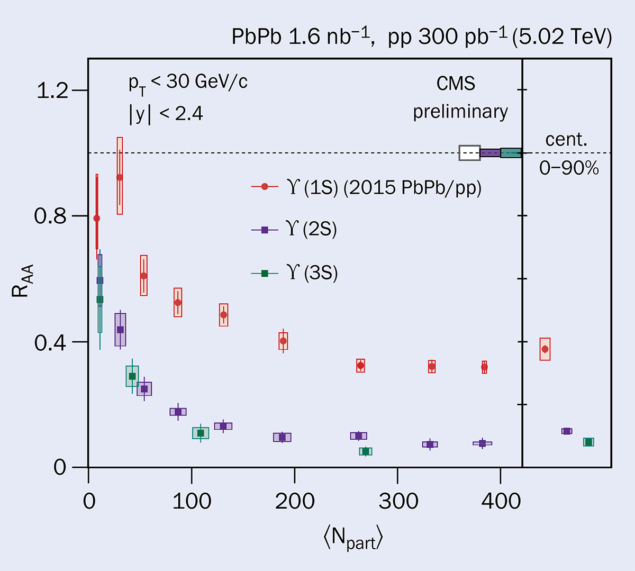A report from the CMS experiment.

The bound states of a heavy quark and its antiquark, called quarkonia, have long been regarded as ideal probes to study the quark–gluon plasma (QGP) formed in high-energy heavy-ion collisions. The golden signature is the suppression of their production yield in lead–lead (PbPb) collisions with respect to extrapolations from proton–proton (pp) collisions, caused by modifications of the binding potential in the QGP. The suppression of the different quarkonium states is expected to depend on their binding energies. Quarkonia can also be produced by recombination processes. The ϒ states (bound states of b quarks and antiquarks) are much less affected by recombination effects than charmonium states, given the very small probability that b quarks are produced. A comparison of their suppression patterns is particularly informative because of the different binding energies of the ϒ(1S), ϒ(2S) and ϒ(3S) states.
The suppression of quarkonium production is quantified via the nuclear modification factor RAA, defined as the ratio between the yield in nucleus–nucleus (AA) collisions and the yield extrapolated from pp data. Previous measurements of RAA for the ϒ mesons by experiments at RHIC and the LHC revealed a significant suppression of the ϒ(1S) state and a larger suppression for the ϒ(2S) state. However, these experiments could only set upper limits for the ϒ(3S) state due to its very low production yield. The CMS experiment recently changed this situation by presenting the first observation of the ϒ(3S) meson in heavy-ion collisions. The ϒ mesons are detected using their decay to two muons. The analysis used the large PbPb data sample collected in 2018 and extracted the ϒ(3S) signals from the large background of muon pairs by using a boosted decision tree algorithm.
The new RAA results are shown together with the previously published ϒ(1S) values as a function of the average number of nucleons participating in the PbPb collisions, <Npart> (figure 1). Collisions with larger <Npart> show a bigger overlap between the two nuclei, producing a larger and hotter QGP. As previously observed, the degree of suppression increases from peripheral to central collisions, i.e. as Npart increases, indicating a more substantial dissociation effect at higher QGP temperatures. The new ϒ(3S) suppression measurement completes the picture of suppression patterns for five different quarkonium states, which was started 35 years ago at the CERN SPS with the J/ψ and ψ(2S) results of NA38. The stage is set for a deeper understanding of deconfinement in the QGP.








